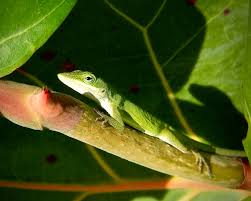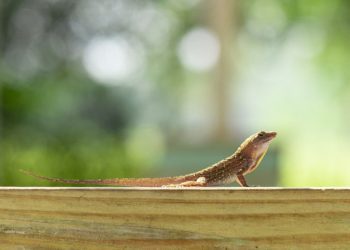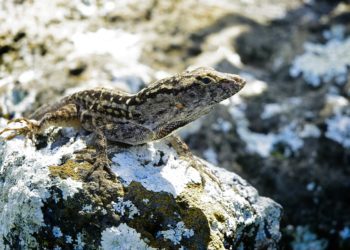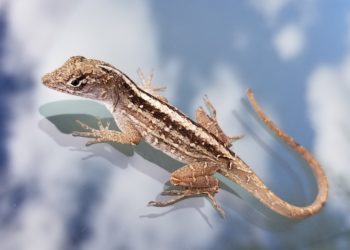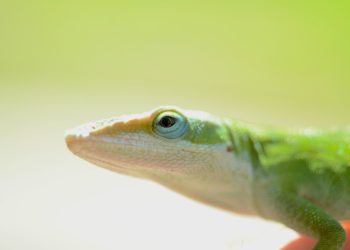The most common species of anole is the green one which is also called Carolina anole. They are famous as pet animals but owners often get confused about their various gestures. They enact in different ways when they are stressed, angry or anxious. Here we will be discussing the colour-changing functionality of the green anoles and the prospective reasons behind this.
Anoles act differently in a different situation. They sometimes gape, and sometimes twitch their tail. Also, they dig and change body colour at different times to emote different emotions and feelings.
Sometimes anole is mistakenly called chameleon but in reality, anoles cannot change their body colour so much like a true chameleon. There are a variety of colours in which chameleons can be changed, but this is not true in case of anoles, they can only turn to brown or yellow. They can turn their body to various shades of brown when they are not feeling well.

Contents
How anoles change the colour?
There is an element called chromatophore in the skin of the anoles which stays on a separate layer of the anole’s skin. The yellow colour occurs due to the presence of xanthophore and the black pigment called melanophore lies in the deepest layer of their skin. When they are excited a hormone that instigates the concentration of melanophore is secreted and thus their body colour changes.
Why anoles change the colour?
Anoles can change the colour rapidly and it often helps them to camouflage into the trees and nature. This reptile is not very verbal about their feelings, so scientists think they try to communicate through the visual methods.
Self-defence
Another reason for their colour-changing is, they are prey to many birds. To avoid detection from the top or from any side, they change the body colour and make itself invisible into the lush foliage. Even the dark brown ones get quite faded while they are seen against the dark brown bark of the trees. Changing the body colour is one of their defensive skills against predators and they stay safe by means of this method.
Change in the background colour
This is actually related to the previous topic. Anoles are able to change the colour of their body to match the background, and they do so to protect themselves from any birds and other creatures that may devour them. Now even when they are not exposed to such threats, they tend to change the colour to match the background and surrounding and become invisible.
Saving territory
They are pretty territorial and show their aggression by the colour change of their body. There is no direct link to colour changing, but as colour-changing is the aftereffect of some hormonal secretion, this takes place when they are excited or agitated.
When they see another male anole in the same ground, they get defensive and try to protect their cage or land, wherever they are.
During this time they gape, may sway their body or arms and sometimes their body colour change to dark green. When one is seen in dark green colour and the other is turning brown, then you can detect that the dominant anole has been defeated the submissive one. The defeated one is getting depressed, afraid or sad which is shown in the change in its body colour.
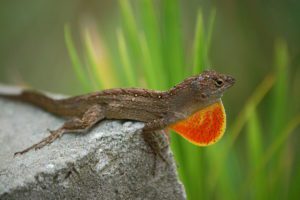
Change in temperature:
It was long assumed that due to external temperature change, they change the body colour, which is only one of the many reasons for their colour changing. But a recent study shows the colour changing is not directly linked with the weather and atmospheric change always, though in some situations they enact this colour changing way.
However, still, it is a popular belief, and even in some cases, it has been seen to be true, that on humid days, the anoles turn to be a darker shade of grey. This can be caused by the mood fluctuation that is normal among all creatures. As anoles love hot and humid weather, when it is dark and cloudy outside, they do not feel cheered up. This depressed disposition may initiate the secretion of a certain hormone which may make the anole look dull grey
On the other hand, when the bright green colour is seen on the anole, it means the weather is sunny and warm, and the anole is feeling refreshed and energetic. The usual colour of a happy anole is bright dark green.
During mating season
Also in the mating season, they express the wish to mate by this visual medium. This is believed by a few scientists that they change the colour to allure the female anole and beat the other male anole in the vicinity by making itself attractive. This is the basic genetic feature that is seen in various creatures when they need to stabilize their own gene. They always want another male of the same species to be defeated so their own gene continues to stay in the race.
When anole turns yellow?
Not the whole body but the dewlaps of the male anoles can turn yellow when they are trying to protect the territory. This happens when they see any male anole approaching its cage or when it is left to the ground and it sees another male anole near it.
Also, the dewlap is seen in the female anoles when they are excited about some reasons. Some anole can move this part of the dewlap while others just have it.
Turning the dewlap yellow or orange is a common gesture among the anoles which is seen when they are perturbed due to some reason.
When green anole turns brown?
The change of colour of anole into brown shows their inactive period. This often happens during the cloudy weather. The weather becomes too humid and moist which results in the change of the body colour of the anole. However, not always the dull weather can cause them to change into the shade of brown.
More:



